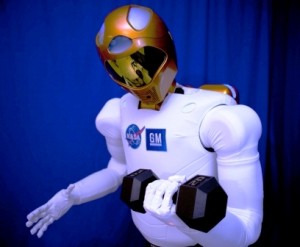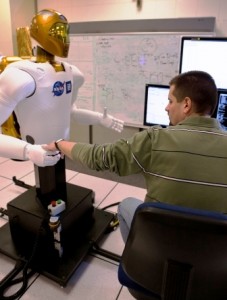Engineers and scientists from NASA and General Motors Company are working together through a Space Act Agreement to build a new humanoid robot capable of working side by side with people.
At NASA’s Johnson Space Center in Houston living people are exploring control, sensor and vision technologies. Future robots could assist astronauts during hazardous space missions and help GM build safer cars and plants, according to program workers.
Successful robots could eliminate entirely the need for people to risk the hazards of space exploration.
The two organizations, and engineers from Oceaneering Space Systems of Houston, developed and built the next iteration of Robonaut or Robonaut 2. Testing is ongoing.
R2, while not nearly as cute as R2-D2 of Star Wars fame, is said to be faster, more dexterous and a more technologically advanced robot than previous, non-movie versions. No word if R2 has a taser, though.
This new generation robot can use its hands to do work beyond the scope of prior machines. R2 can work safely alongside people, a necessity both on Earth and in space.
“This cutting-edge robotics technology holds great promise, not only for NASA, but also for the nation,” said Doug Cooke, associate administrator for the Exploration Systems Mission Directorate at NASA Headquarters in Washington.
“I’m very excited about the new opportunities for human and robotic exploration these versatile robots provide across a wide range of applications,” Cooke said.
Using dexterous, human-like robots capable of intricate work is not new to the aerospace industry, of course. The original Robonaut, a humanoid robot designed for space travel, was built by the software, robotics and simulation division at Johnson in a collaborative effort with the Defense Advanced Research Project Agency 10 years ago.
During the past decade, NASA gained significant expertise in building robotic technologies for space applications. These capabilities will help NASA launch a “bold new era of space exploration.”
“For GM, this is about safer cars and safer plants,” said Alan Taub, GM’s vice president for global research and development. “When it comes to future vehicles, the advancements in controls, sensors and vision technology can be used to develop advanced vehicle safety systems. The partnership’s vision is to explore advanced robots working together in harmony with people, building better, higher quality vehicles in a safer, more competitive manufacturing environment.”
NASA and GM have a history of collaborating on key technologies, starting in the 1960s with the development of the navigation systems for the Apollo missions. GM also played a vital role in the development of the Lunar Rover Vehicle, the first vehicle to be used on the moon.


